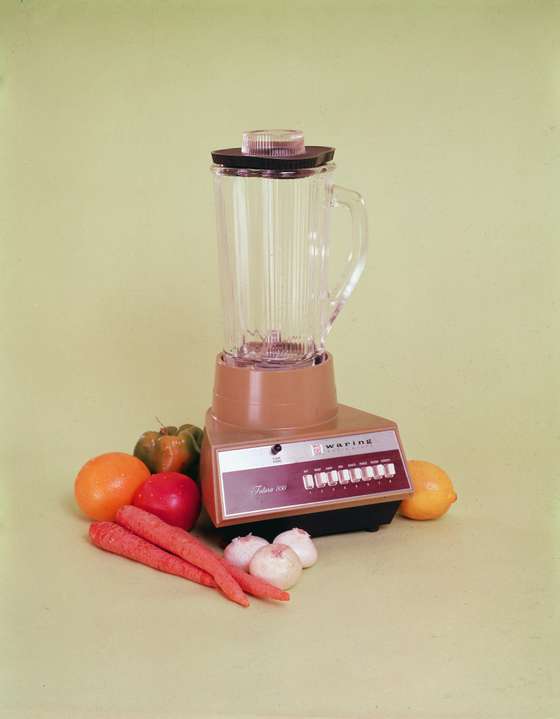Is there a world where the deep fryer doesn’t take pride of place on the kitchen counter? It may seem far away, but the truth is that this hot air fryer—said in good Portuguese—has only recently been part of the set of home appliances. In Portugal it began to appear in 2018, registering the boom from 2020 until now, with DECO Proteste testing, in 2023, 44 of these devices to see if “they presented good build quality, had no security problems and were versatile.” and relatively easy to use.”
It is known that the deep fryer has changed the dynamics of a kitchen: it works like a small stove that prepares the most varied foods – such as meat, fish, vegetables and even cakes – using little or no fat or oil, in a healthier way. and more efficient in less time than a traditional oven or fryer. Before this, there were other appliances and utensils that over the years have revolutionized the kitchen and the way of preparing meals. From the cloche, also known as patusca, to the Bimby, through tupperware and coffee makers, we have put together seven. Each one in their own way, and with a different function, marked their path until reaching today. Some are still in use, others have declared bankruptcy, and there are even some that have been forgotten, in a kitchen cupboard.
Mixer, from manual to electric
Versatile and manual, the hand-cranked mixer began to be developed in the 1850s and was used to mix virtually anything needed. After being adapted in the following years, it was not until 1919 when the electric one appeared, from the hand of Herbert Johnson, which would revolutionize the lives of those who were in the kitchen. That year, the American engineer, born in Ohio, created the H-5, the first domestic egg beater. Still in the testing phase, one of the wives of the directors of the Hobart Manufacturing Company commented that it was the “best kitchen utensil.” The name stuck, giving rise to the brand that still endures today: KitchenAid.

In the 1920s, the brand’s campaigns focused on the versatility of the mixer, resulting in the sale of 20,000 H-5 mixers in the first three years on the market. In 1936, technology met design with Egmont Arens, publisher of Creative Arts magazine and Vanity Fair, and partnered with KitchenAid to create three of the best-known models, including the famous K, which still inspire new kitchens today . These were not introduced in Europe until the 1980s, arriving in Portugal shortly after, in the 1990s.
Tupperware
It may have declared bankruptcy in September of this year, but forever, any plastic container stored in your kitchen cupboard will be called Tupperware, even if it’s not the brand. Created in 1944 by American engineer Eal Siles Tupper, Tupperware was revolutionary in the world of cooking by designing iconic airtight containers to help families preserve food during the post-war period. His first product became known as the “Wonderful Bowl” because of the advantages it offered over the traditional ones that existed at the time: it was lighter and less prone to breaking compared to glass and traditional tableware. However, greater success only came later, in 1948, when Brownie Wise introduced a more effective way of getting Tupperware products to consumers, using the door-to-door demonstration sales method, the so-called “Tupperware parties.” allowing many women to have a professional career, thus creating a community aimed primarily at their families.
Tupperware arrived in Portugal in 1967, offering a response to all needs, allowing you to preserve or serve any type of food. Currently, the brand is present in more than 100 countries and since the 90s it has not stopped innovating and revolutionizing food storage and preparation. In September, the brand filed for bankruptcy after warning last year that it was in a difficult financial situation, however, it explained that it “will continue to operate” during the bankruptcy process and that it will try to obtain court approval for a bankruptcy process. sale of the company. “We plan to continue serving our valued clients (…) throughout the process,” explained Laurie Ann Goldman, president and CEO of the company.
In any case, Tupperware is already so well integrated into everyday life that the name is no longer just a brand name. Today it is synonymous with a category of products, and this is how it appears in Portuguese dictionaries: in the Priberam online dictionary, Tupperware is defined as “a plastic container used to store food, usually with an airtight lid.”
Wonderful bowls, Wonder Woman
Blender
Although its origins date back to the early 1900s, in England, it was not until 1919 that the Polish inventor, based in the United States, Stephen J. Poplawski began to design what in 1922 would be launched on the market as the blender we know today. . today: a glass cup with a rotating blade at the base that operates electrically. Initially used to prepare typical North American smoothies, the blender did not begin to gain popularity until the following decade, in 1937, with the launch of Fred Waring’s “Waring Blender”, which is still manufactured today, but with updates.
Following the trend of domestic modernization, the blender was introduced in Portugal between the 50s and 60s, with Europe, influenced by the United States, developing the Turmix Standmixer blender, which later gave rise to another type of appliance: a juice extractor. of any fruit. or vegetable, which was also available as a separate accessory that fit into that device.

Cloche (or patusca)
There are few Portuguese homes that do not have an inactive hood above the refrigerator or a kitchen cabinet, waiting to be finally used after so many years. In vogue in the late 1970s, and remained so until the 1990s, this was the electric oven that, at the time, everyone wanted. Round in shape, everything could be cooked inside, from sweets to savory dishes, and, to the delight of those who bought it, it consumed little electricity compared to a traditional oven. It was also a good option for those who did not have an oven in the kitchen. As Portuguese as it has become, with diffuse origins, the bell was also affectionately called “patusca”.
coffee machine
Classic coffee makers had a well-established place in Portuguese homes. With a paper filter, ground coffee and hot water, they served bowls and cups for those who enjoy coffee – or for those who needed it to wake up. However, in Switzerland, Nestlé saw coffee capsules as a more practical way to prepare espresso and launched the well-known Nespresso in 1986. The first coffee machine with a capsule system arrived in Portugal in 1999 and gained popularity in offices for its convenience and speed of coffee preparation. In 2008, Delta Cafés sought to offer an alternative to the growing capsule market and launched the first, with the Delta Q system. Over the years, coffee machines have moved from offices to Portuguese homes, which continue to have a coffee maker classic. the kitchen counter, due to the search for the same convenience and quality of coffee that they found in the workplace.
thermomix
In Portugal it is known as Thermomix but if we talk to the company that created it, the German company Vorwerk, it is identified as Thermomix. The kitchen robot is one of those that has revolutionized the kitchen the most in recent years, having become popular since 2000, in Portugal, with 2012 being the best year of sales, registering 35 thousand units. Accessible and efficient, the Thermomix made the cooking process easier, being able to cut, mix, crush, knead, boil, bake and steam. However, its origins date back to 60 years ago, when Vorwerk developed the first Thermomix: it was called VKM5 and was born from the combination of mixers developed by the company.
Associated with the Cookidoo platform, Bimby presents himself as a sous chef who knows more than 40 thousand recipes. Multifunctional, it is used to prepare complete meals, soups, ice creams and even complex desserts. In addition to those mentioned, it also has five special modes: turbo, slow cooking, caramel, kettle and self-cleaning; However, it makes cleaning the cup easier after use.
air fryer
We go back to the beginning and to the most recent appliance that has revolutionized kitchens. Healthy fries? They exist and are made in the Air Fryer, the fryer that circulates hot air around the food it cooks, leaving them just as crispy and crunchy as if they were made in a traditional fryer. The concept became popular in 2010, when Philips launched the first oil-free fryer, but it was not until the Covid-19 pandemic, in 2020, that this device began to gain more popularity in Portugal.
Both for being a healthier way of cooking – since it uses 50 times less fat – and for its speed, the deep fryer has become a must have in the homes of so many Portuguese people who use it to prepare any type of food. Whether fried, boiled or roasted, the device allows you to prepare meat, fish and vegetables, and even desserts and breads. One of the other advantages is the fact that the fryer basket can be opened during use, allowing you to always have a view of what is being cooked.
Source: Observadora
